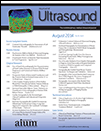Sonography of the Lateral Antebrachial Cutaneous Nerve With Magnetic Resonance Imaging and Anatomic Correlation
Abstract
Objectives
Abnormalities of the lateral antebrachial cutaneous nerve (LABCN) are associated with antecubital elbow conditions, such as distal biceps brachii tendon tears and traumatic cephalic vein phlebotomy. These can lead to lateral forearm, elbow, and wrist symptoms that can mimic other disease processes. The purpose of this study was to characterize the sonographic appearance of the LABCN using cadaveric dissection and retrospective analysis of sonographic examinations of symptomatic patients with magnetic resonance imaging correlation.
Methods
For the first part of this study, a cadaveric elbow specimen was examined, and sonography was performed after dissection to identify the LABCN. Subsequently, 26 elbows in 13 patients with LABCN abnormalities were identified with sonography and retrospectively evaluated to characterize the appearance of the LABCN in both symptomatic and asymptomatic elbows.
Results
The symptomatic LABCNs showed fusiform enlargement, increased echogenicity, and loss of the normal fascicular echo texture. The mean cross-sectional area of the symptomatic nerves was 12.0 mm2 (range, 6.1–17.2 mm2), with a maximum thickness of 3.5 mm (range, 2.3–5.9 mm), compared to 3.3 mm2 (range, 1.9–5.2 mm2), with a maximum thickness of 1.3 mm (range, 0.9–2.2 mm), in the contralateral normal elbows.
Conclusions
The close proximity of the LABCN to the distal biceps tendon and the cephalic vein makes it vulnerable to compression and injury in the setting of distal biceps tendon tears and traumatic phlebotomy, which may cause nerve enlargement and increased echogenicity. Awareness of the location and appearance of the LABCN on sonography is important for determining potential causes of lateral elbow and forearm pain.




